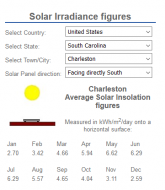Thanks, I would appreciate any suggestions. Here is what I have figured
20 Led Lights 32 watts
1 Refrigerator 700 2200 surge
1. Well Pump 1600 4500
1 Electric water heater 4500
1 TV 500
1 Clothes dryer 5400
2. garage door opener 2350 4700
1 Air compressor 1600 4500
1 coffee maker 1000
1 Electric drill 600 900
1. Electric stove 2100
1. Heat pump 4700 4500
The refrigerator surge I believe, because the 700W peak running is a resistive heating element. motor is only 200 to 400W.
Not so sure about well pump 4500. I would assume 5x 1600 for 8000W surge.
Garage door opener I don't believe 2350 running watts.
Air compressor, 8000W surge
Heat pump - what is the nameplate rating for refrigerator compressor? It may have resistance heating backup. If 4500 or 4700W is compressor running watts (believable for good sized system), then 20,000W or so surge.
2x Sunny Island would deliver 11,500W continuous from battery, 22 kW surge for 5 seconds.
Continuous power derates at higher temperature, down as low as 4400W at 140F, so good to install inside air conditioned space. (along with your batteries)
You can connect almost any amount of AC coupled Sunny Boy PV inverter, depending on how many Wh per day you need. Maximum with 2x SI6048 Sunny Island would be 4x Sunny Boy 7.7 kW for about 30 kW peak. With typical "maximum" PV panel array all oriented one direction, would produce 150 kWh/day in the summer. You could connect about 60 kW of PV panels with multiple orientations (Morning/Afternoon, or Summer Morning/Afternoon & Winter Noon) for more level power throughout the day and some clipping middle of the day, about 250 kWh/day.
If you have a generator, it will auto-start when batteries low, recharge, stop generator. That would let you have smaller battery and PV array. For instance, size battery bank for just one night instead of 3 days. That could be 1/6 or 1/12th as big, since most use is expected to be daytime.
Water heater should be enabled as a "dump load", to take excess PV production when nothing else needs power. Same for clothes dryer, but of course a clothesline is a practical alternative.
You could set up priority switching between major loads, if there is a problem supplying all at once. For instance, air compressor pressure control could be wired to interrupt heat pump thermostat. Both of those could interrupt well pump. Or, use a battery SoC signal to shed larger loads (Sunny Island has programmable relays for that), e.g. only run well pump at > 80% SoC.
With the maximum Sunny Boy PV configuration of twice the Sunny Island battery inverter, only half the power production can go to battery. The rest can be consumed as AC, or else production is curtailed.
Refrigerator doesn't need to run at night. A top freezer model lets cold air spill to the fridge. Smaller battery needed.
One reason I like AC coupled PV (besides highest efficiency for the grid-tied net metering which is most of my usage), is that battery can be arbitrarily small. I have programmed 80A (4kW) recharge rate, but have PV capacity several times that. During grid failure, my batteries recharge gradually in the morning and then float, while PV generated power is curtailed to supply that plus A/C and other loads. PV is much cheaper than batteries, so I waste excess production rather than trying to store more than one night's worth.
My system is similar to what I described except it has 4 Sunny Island for 23 kW from battery, half as much Sunny Boy. 20 kWh of AGM battery. My moderate climate doesn't need as many kWh for AC. Off-grid operation is infrequent, so AGM battery for 800 deep discharge cycles isn't used nightly, expect 10 year life.



